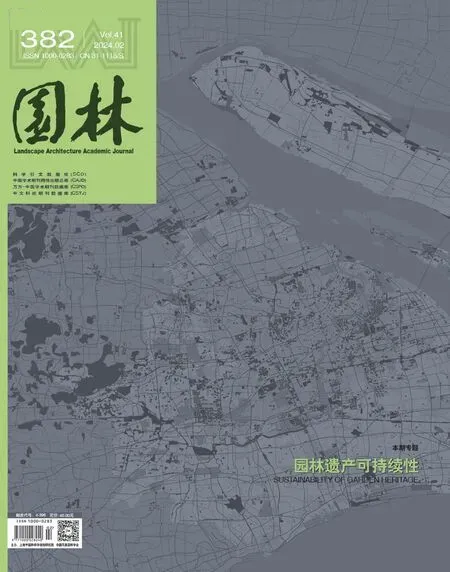走向永续的未来:园林遗产的保护与可持续发展
自1982年《佛罗伦萨宪章》提出“历史园林”的概念以来,针对园林遗产的保护和研究工作一直在持续开展。随着《世界遗产公约操作指南》的修订与实施,以及对园林遗产的保护、修复和价值研究的深入,逐渐形成了独到的保护理念。在中国,园林遗产保护主要针对静态的园林结构及其物质组成,具体涉及保护、修复与监测预警三个方面。按照“保护为主,抢救第一”的原则,大多数项目侧重于“抢救性保护”,并以地方园林及绿化管理机构为主导,缺少系统性的保护,公众参与相对较少。在此背景下,如何推动园林遗产朝着更加体系化和可持续的方向发展,已成为一个紧迫的课题。党的十九大报告强调加强文物和文化遗产的保护与传承,活化非物质文化遗产;2021年,自然资源部和国家文物局的指导意见也提出了历史文化遗产活化利用,2023年的文化遗产保护传承座谈会更是聚焦“坚持传承优先”理念,强调了“在保护利用中永续传承”,这些都标志着文化遗产保护与活化的系统性和可持续性探索正在全面推进。
园林遗产是文化遗产不可或缺的一部分,它不仅是人类在漫长的社会生活中对美好物质与精神生活的具象化体现,更是社会与经济发展的时代缩影。园林遗产凝聚了时代变迁与人文精神碰撞的火花,承载了自然山川与江河湖海的壮丽缩影。因此,保护和传承园林遗产是保护和传承中华文脉的重要一环。目前,传统的园林保护措施主要存在体系性不足和保护、修缮方法不当等问题。当下,保护策略正从传统的单一资源保护转向可持续性和预防性保护,并逐步整合活态的非物质要素。此外,从更广阔的城市和区域角度来优化遗产工作模式和方案,并进行评估,推动园林遗产与城市更新、多技术方法和多学科的合作,是赋予遗产持续生命力的关键。
本期专题聚焦于“园林遗产的可持续性”,探讨了园林遗产的可持续理论框架、创新实践和路径转型。从园林个体和城市整体两个互补的视角出发,深入研究了经济、社会、环境和文化等多方面的遗产可持续发展手段和策略,并总结了“目标体系—具体策略—支撑体系”的发展策略框架;梳理了江南园林数字化研究的现状,并从遗产数字化的内容和管理层面探讨了数字时代江南园林的可持续发展路径。同时,分析了园林非遗营建技艺面临的发展困境,探讨了高校在保护江南园林非遗营建技艺方面的优势,并总结了通过抢救性保护、动态性传承、活态性传播三方面来促进非遗营建技艺传承的路径转变。此外,专题文章还复原了昭庆寺的历史沿革、建筑布局、植被景观和园林活动,并探讨了圩田传统对宋代西湖风景营建的影响,从而突显文化遗产的时代价值。
作为世界文化遗产的重要组成部分,中国园林遗产的可持续性不应局限于单个遗产或其组成要素。我们应该将活化应用、区域协作、非物质文化遗产保护和传承等纳入其中。展望未来,希望园林遗产领域的专家学者能够从更宏观的视角出发,推动高质量、高效率、高层次的保护与活化工作,实现园林遗产多主体、多领域、多层次的系统性可持续发展,让园林遗产走向永续的未来。
南京林业大学风景园林学院教授
江南园林遗产保护与活化江苏省文化和旅游重点实验室主任
2024年1月4 日
Towards a Sustainable Future: Conservation and Sustainable Development of Garden Heritage
Since the concept of “historic gardens” was introduced in The Florence Charter in 1982, the conservation and research of the garden heritage has been continuously carried out.With the revision and implementation of The Operational Guidelines of the World Heritage Convention, as well as in-depth research on the conservation,restoration and value of garden heritage, unique conservation concepts have gradually been developed.In China, the conservation of garden heritage mainly focuses on the static garden structure and its material composition, specifically involving three aspects: conservation, restoration and monitoring and early warning.According to the principle of “conservation first, salvage first”, most projects focus on “salvage conservation” and are led by local garden and greening management organizations,with a lack of systematic conservation and relatively little public participation.In this context, how to promote the development of garden heritage in a more systematic and sustainable direction has become an urgent issue.The report of the 19th CPC National Congress emphasizes strengthening the conservation and inheritance of cultural relics and cultural heritage, and revitalizing intangible cultural heritage; In 2021,the guidance of the Ministry of Natural Resources and the National Cultural Heritage Administration also proposed the activation and utilization of historical and cultural heritage.The 2023 symposium on the conservation and inheritance of cultural heritage focused on the concept of “adhering to the priority of inheritance”, emphasizing “sustainable inheritance in the conservation and utilization”, which marks that the systematic and sustainable exploration of cultural heritage conservation and activation is being comprehensively promoted.
Garden heritage is an indispensable part of cultural heritage, which is not only the embodiment of the beautiful material and spiritual life of mankind in the long social life, but also the microcosm of the times of social and economic development.The garden heritage unites the sparks of the collision between the changes of the times and the humanistic spirit, and carries the magnificent epitome of the natural mountains and rivers and lakes.Therefore, the conservation and inheritance of garden heritage is an important part of the conservation and inheritance of Chinese culture.At present, the traditional garden conservation measures mainly exist in the systematic insufficiency and improper conservation and repair methods and other problems.Nowadays, conservation strategies are shifting from traditional single-resource conservation to sustainability and preventive conservation, and gradually integrating living intangible elements.In addition, optimizing heritage work models and plans from a broader urban and regional perspective, conducting evaluations, and promoting cooperation between garden heritage and urban renewal, as well as multi technological methods and disciplines, are key to endowing heritage with sustained vitality.
The topic of this issue focuses on “Sustainability of Garden Heritage”, exploring the theoretical framework, innovative practices and paths of transformation of garden heritage.From the complementary perspectives of individual gardens and the city as a whole, in-depth the means and strategies for sustainable development of heritage in economic, social, environmental and cultural aspects were studied, and the development strategy framework of “target system-specific strategy-support system” were summarized; The current situation of digitization research of Jiangnan gardens was sorted out, and the sustainable development path of Jiangnan gardens in the digital era was discussed from the content and management level of heritage digitization.At the same time, the development dilemma faced by the non-legacy camping skills in gardens was analyzed, the advantages of universities in protecting the non-legacy camping skills in Jiangnan gardens were discusses, and the transformation of the path to promote the inheritance of non-legacy camping skills through the three aspects of salvage conservation, dynamic inheritance, and living dissemination were summarized.In addition, the feature article restored the historical development, architectural layout, vegetation garden and garden activities of Zhaoqing Temple, and explored the influence of the polder tradition on the construction of the West Lake landscape in the Song Dynasty, thus highlighting the contemporary value of cultural heritage.
As an important part of the world cultural heritage, the sustainability of China’s garden heritage should not be limited to individual properties or their constituent elements.We should include revitalization and application, regional collaboration, and intangible cultural heritage conservation and inheritance.Looking ahead, we hope that experts and scholars in the field of garden heritage can promote high-quality,high-efficiency and high-level conservation and revitalization from a more macroscopic perspective, so as to realize the systematic sustainable development of garden heritage in multiple subjects, fields and levels, and to make the garden heritage move towards an everlasting future.
Professor, College of Landscape Architecture, Nanjing Forestry University Director, Jiangsu Provincial Key Laboratory of Culture and Tourism for Conservation and Revitalization of Jiangnan Garden Heritage
January 4th, 2024

